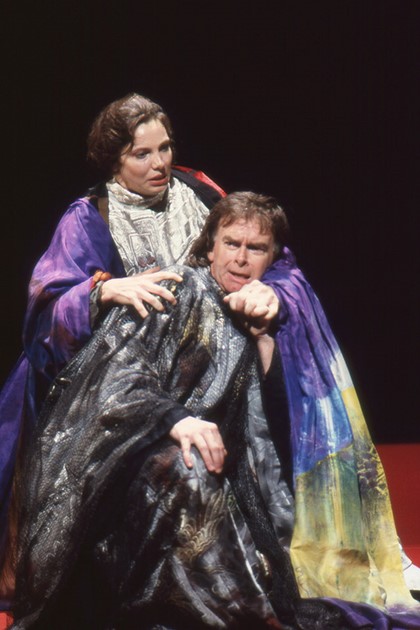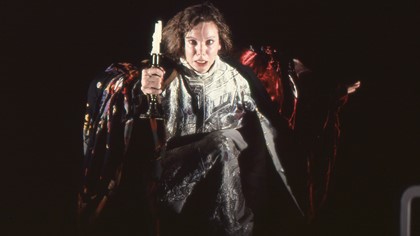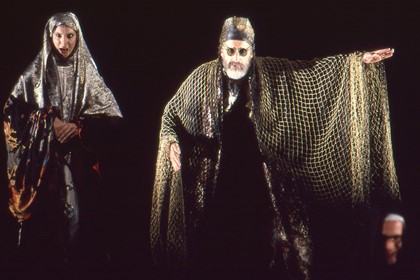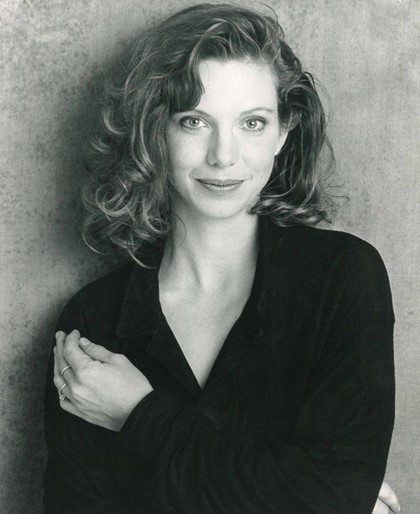Throughout the 1980s and 90s Playbox, along with its commitment to develop new Australian writing, also pursued a strong policy of regional engagement with Asian theatre makers and companies. Perhaps the most significant of these was with world-renowned Japanese director Tadashi Suzuki in a thrilling production which, as Rob Reid discusses, left a profound impact.
In the 1920s following the Meiji Restoration, the Shin-geki (New Drama) movement arose and spread, influenced by western drama, particularly Stanislavski at the Moscow Art Theatre. The 1960s gave birth to a new movement that questioned the motives and relevance of the Shin-geki movement, claiming it was didactic and elitist. It was also criticized for blindly taking western scripts and believing that all that was required of actors and directors was to make them life like. In 1966, the most vocal troupe to oppose Shin-geki was the Waseda Sho-gekijo company led by Tadashi Suzuki that would eventually become the Suzuki Company of Toga.
Suzuki is considered one of the world’s great directors, regularly compared with Stanislavski and Peter Brook. From the beginning his works were experimental, rejecting naturalism, for a more physically embodied performance style. He began his career working on contemporary Japanese texts but later shifted to interpreting more classic European texts including works by Euripides, Chekov and Shakespeare.
The SCOT company is based out of Toga, a small village in the mountains of far northwest Japan, where he produces his own Summer theatre festival, as well as producing a second festival in Mito, north of Japan. He also co-founded the Saratoga International Theatre Institute with American director, Anne Bogart.
Suzuki toured his celebrated production of The Trojan Women to the Sydney Opera House in 1988 and in 1989 he presented his adaptation of The Bacchae at the Victorian Arts Centre in partnership with Playbox as part of the Spoleto Melbourne Festival of the Arts. This production became the touch stone for further conversations between the two companies to begin work on the collaboration that would become The Chronicles of Macbeth.
In 1991 the Australian Federal Government launched a new policy initiative placing increased emphasis on future cultural development in the Asia Pacific region. The Minister for Foreign Affairs, then Senator Gareth Evans, announced the Australia Councils’ decision to encourage its boards to direct up to 50 per cent of their international budget to the Asia and Pacific region by 1992-93, saying that the decision 'would be of great assistance to Australian diplomacy.'ᶦ
That same year six Australian actors, including Playbox’s Artistic Director Carrillo Gantner, traveled to Toga for three weeks to train with Suzuki in his unique acting technique. Australian Japanese theatre expert, Dr. Ian Carruthers, described the approach, which would become known as the Suzuki Method, saying:
'Suzuki’s is a theatre of resistances, tensions and oppositions which trains the performer in intense emission and repression of physical power. He describes the actor trained in his method as having the allure of a racing car. What matters is not so much the 'chassis' (good looks) but having a powerful 'engine' (capable of sustained high energy performance in all situations) and very strong 'brakes' (concentration and control). By contrast, Suzuki sees the naturalistic actor as having a nice chassis and maybe good brakes – but a feeble engine. If the ultimate acting achievement is to be able to hold audience attention and interest without seeming to do anything then these must be charged with potentiality – like a racing car at the starting line, its engine gunned at full throttle awaiting release of the fiercely applied brakes. By extension, a large part of Macbeth’s dramatic interest comes, not from seeing how well he expresses his fear (what Suzuki would call naturalistic description) but from seeing his struggle to control and suppress it.'ᶦᶦ
The production of The Chronicles of Macbeth was much anticipated and caused a great deal of discussion in Melbourne in the lead up to its opening. Reports of Suzuki’s early visits to the Malthouse to see the Malthouse Theatre complex and the Merlyn theatre, for which the production was being developed, noted that at the time Suzuki was thinking of directing The Marquis de Sade by Yukio Mishima with the six female roles being played by males. This idea was soon discarded however Suzuki considered it might be too controversial a choice and that 'it could be seen as an ‘act of colonisation’—a Japanese director importing a Japanese play into Australia,' but that this would not be the case if he was to adapt an English language classic.
Janice Breen, writing for The Age in Melbourne, described Suzuki’s arrival at the Malthouse Theatre:
'… Suzuki carried two of the elderly kimono costumes from his play… into the Malthouse Theatre carpark in South Melbourne. An assistant held them up in the sunlight as Mr Suzuki worked them over, crisscrossing the kimonos crust of gold, silver and coloured thread embroidery with a misty plume of black paint from a spray can. Delicate needlepoint flowers, landscapes and birds blurred to black. What was vivid and gleamed before was now partially eclipsed; there in essence but now minus the gold. It was an elegant piece of vandalism and one that obliquely captured the essence of what has become known as Suzuki theatre.'ᶦᶦᶦ
His Japanese language version of Macbeth had its premiere at the Mito festival early in 1991 with a cast of 27 and included spectacular stage effects. An Australian version would have to be less ambitious, with a cast of only 12. Suzuki said at the time that in Japan he was 'able to call on people like the lighting director and the stage manager to play small parts, but in Australia union rules would probably prevent that.'ᶦᵛ Ultimately, the Australian cast included 11 Australian actors and one international performer, Suzuki’s long time collaborator American actor Ellen Lauren.
Suzuki’s rehearsal process was renowned for its demanding physical rigor and Lauren described Suzuki’s approach to the training and rehearsal, saying 'Mr. Suzuki says it is a ‘blood test’, to match your own abilities against others, to see where you fall. The course is designed to place many obstacles before you. Mr. Suzuki makes the actors stomp their feet on the ground, which creates a great deal of energy that infiltrates the upper body. The actors job is to keep that down and centre it in the pelvic area, allowing the upper body to remain free, the voice to remain mobile and the breath to remain controlled….It is extremely physical. When the actors work together, we try to breath together and anticipate each other’s moves. It is like a great opera, singing a duet, but like a singer you have to anchor yourself and not be moving round all the time.”ᵛ
The Australian actor, Peter Curtain, who played Macbeth in this production described working with Suzuki, saying 'Mr. Suzuki is always stressing the need for us to pare back. Even if you move once every two minutes, that has a much greater impact. Everything is structured and dense.'ᵛᶦ
This drive to pare back was also noted by the set designer for the production, John Beckett. The minimalist set Beckett designed, consisted simply of ten chairs and a set of steps. He explained in the SBS documentary about the project that:
'I tried to design a set which I called the Claytons set, the set you’re having when you’re not having any set, cause I had the suspicion that he might throw things away so I talked to a number of his production staff, and said, well, what evidence does he normally work with, and I looked at photographs of his other productions, and came up with what I thought was the design we might get away with, by the time he’d finished throwing bits away. But I wasn’t quite ready for the fact that he was going to throw the whole thing away and we’d start from scratch.
One of the technical problems, we needed for tour around Australia and certainly the Malthouse here, was that we needed a way to protect the floor. The staves that he uses in the chorus, the force that the actor hit to floor with those staves, is extremely hard. He originally wanted to use tarkett, it’s a plastic dance floor which he uses in Japan, but we tested that and tore it to shreds in the first three or four blows, so we designed the floor that we’ve got, which is slightly sprung. Because we knew that—having watched the work—that the force of the actors was the same sort of force as a dancer jumping on a floor.'ᵛᶦᶦ
The Chronicle of Macbeth premiered in the Union Hall in South Australia as part of the 1992 Adelaide Festival of the Arts on February 28th, and then transferred to the Merlyn Theatre in the Malthouse on March 12. It was a challenge for some critics to come to grips with the adaptation, as Len Radic, speaking in the SBS documentary makes clear when he says:
'I criticized the work not for the acting which I think, given the impossible demands made on the actors, was very very strong. Very dedicated and very much what I would have said suited the work itself. The problems lay in the concept. And when I say that, I think the fault therefore lies, in the hands of Suzuki himself, and that adaptation. Now, it wasn’t just that he’d decided to take Macbeth and cut it down, which is legitimate, and take what he saw as the essence of it, which is the conflict between Macbeth and Lady Macbeth… But then on top of that he superimposed this strange cult group, the farewell cult group, and as I remember it, what they were dedicated to was the abolition of history, of memory, and of the past as it were. Now it had a sort of philosophical underlay to it, but I’m sure no one in the audience understood what, the purpose of this strange group was.'ᵛᶦᶦᶦ
Suzuki’s adaptation of the original text reimagines the story as one of illusions and paranoia. The central character is an old man who has come to believe he is the Macbeth from the play and struggles with guilt over his actions. The text itself is cut down to a bare bones interpretation a little over 60 minutes long, which showcases the most memorable scenes and monologues by Macbeth and Lady Macbeth along with a few short contextualising scenes. These are then bookended with a scene written by Suzuki in which a mysterious end of life cult, the ‘Farewell Cult’, who wear robes, Ray-Ban sunglasses and carry long staffs on which are mounted sheep skulls. This cult takes the traditional role of the witches in Macbeth and urges the old man to free himself from 'the burdens of memory, history and even words themselves.'ᶦˣ
Suzuki himself described the thinking behind his adaptation in rehearsal notes given to the cast explaining: 'In western drama, from the Greeks to Shakespeare, we are usually dealing with protagonists who are very clear about their desires and goals. Macbeth is number two and very clear that if he kills Duncan he himself will become king. He exists in a social and political structures in which he can’t make this desire open, but its very clear that he has this desire. … When we see illusions, they are usually linked to strong desires. The man dying of thirst in the desert sees mirages of water… Illusion is founded on strong desire. So why then should we be afraid of illusions which our own desire has drawn up? The reason is because, as humans, we sense the potential for the desire to desire to destroy us. Desire is ambivalent: a strong desire towards something is linked together with the fear that the loss of this something will destroy us utterly. … Macbeth is a play that shows the result of this ambivalence.'ˣ
The Chronicle of Macbeth was in stark contrast with other works being presented at the time. Around Melbourne other theatre programs were presenting more traditional fare, including MTC’s Summer of the Aliens by Louis Nowra and David Williamsons Money and Friends. A Midsummer Night’s Dream was being staged in the Botanical Gardens. Amanda Muggleton was performing Shirley Valentine at the Victorian Arts Centre, which was also hosting a fleeting season of Steven Berkoff’s Salome, created for the Royal National Theatre.
The Adelaide season struggled with reviewers who were perhaps not ready for such a revolutionary adaptation, many of whom took exception to the stark staging and the edits to the text. Bob Evans in the Sydney Morning Herald bemoaned the adaptation: 'For purists, it might seem that in the process of trans-cultural plunder, Suzuki has savaged, even brutalized the text.'ˣᶦ Rosemary Neill in The Australian described the acting as turning on 'the sudden emission and suppression of physical and vocal energies; bodies are rigidified and movements decelerated, and the actor sometimes speak in unison, their collective bark or strange rattling’s of the throat, constricting into a gravelly. The cast also have a habit of attacking their lines as if they are dictating military commands at high speed; the effect is staccato, loud—and often unintelligible.'ˣᶦᶦ It must also be said that there is some fairly ugly racist commentary in some of the reviews, calling it a karaoke version, and saying it 'reeks of the fascist, authoritarian and double talk elements in Japanese society of which the Pacific region would well be rid.'ˣᶦᶦᶦ
By contrast the Melbourne season received much better reviews. John Larkin praised the production at length, saying 'All the rehearsal, all the peeling away of the layers to find the actors essential energy through the extraordinary Suzuki Method of earthing and uplifting them, all the attention to detail while setting the spirit of the production so free, now comes to us as the savage fruit of their labour. The exaltation comes from our efforts too, for this is not a show in which the audience can sit back passively and have all the work done for us. It makes us concentrate, think, feel, listen, look and dream, to a degree of intensity equal if we so choose to that of the show itself. Dark spirits stalk the Merlyn theatre while the air is rent with the sound of dreadful wounding. The effect is overwhelming, with the combination of the vivid costumes and lighting, … the importance of every nuance of movement and inflection, together with the sublime tension of what is taking place, the subterranean stalking of this dismembered mind.'ˣᶦᵛ
Janice Breen writes, 'Mr. Suzuki manipulates every theatrical element of his productions … picking off superfluous details like lint off a mirror. He tolerates no waste, of gesture, facial expression, movement or sound. His sets are stark, meanly lit and his scripts and staging flawlessly evolve into his perceived imagery. The effect is enthralling.'ˣᵛ Barb O’Sullivan called it 'A stunning rendition of one of Shakespeare’s most famous plays,'ˣᵛᶦ and Isobel Deller described it as 'Vigorous and powerful. I have seldom seen such controlled disciplined performances. The chorus work vocally and physically was impeccable. Other actors glided across the stage sweeping their great oriental robes about with flamboyant disdain brilliantly executed.'ˣᵛᶦᶦ
After its Malthouse season, The Chronicle of Macbeth went on to tour to The Alexander Theatre at Monash University’s Clayton Campus, the Ford Theatre in Geelong and the Theatre Royal in Hobart. It then went on to tour to Japan in 1992 to be presented at the Mitsui Festival in Tokyo.
As important as it was at the time as an act of cultural soft diplomacy, the Suzuki/Playbox production of The Chronicle of Macbeth has also had long lasting impact on the theatre community. Many of the actors involved have continued to incorporate some of Suzuki’s training and philosophy into their work, including performers such as Matt Crosby, Bruce Naylor and David Pledger. Pledger, who went on to form the groundbreaking Melbourne Independent theatre company, Not Yet It’s Difficult, had this to say at the time:
'It is really a physical theatre as opposed to characterisation, motivation—they just don’t enter into it at all. What it sets upon you is for your body to work in a particular way so that you start to respond physically as opposed to intellectually or emotionally. …The notion is that you always play to the eye of God. The eye of God may in fact be the eye of God, or your lover, or someone important to you, or something more metaphysical. This object, this thing that you set out for yourself, is a thing which can look at you, perceive you and consider you doing whatever you are trying to do at any given moment. What the audience watches is this relationship between yourself as a performer and this eye of God outside. That’s what begins to make you engaging as a performer.'ˣᵛᶦᶦᶦ
Dr . Robert Reid is an independent playwright, theatre historian, immersive performance designer and critic. They were the artistic director of independent theatre company Theatre in Decay and immersive performance and game company, Pop Up Playground. Dr . Rob's plays have been performed by the MTC and Black Swan, and their immersive works have been presented by the MSO, SLV, City of Melbourne, Bell Shakespeare and the Melbourne Football Club. Dr . Rob has a PhD in Australian Theatre History, was a co-founder and co-editor of WitnessPerformance.com and now runs the YouTube channel, Television is Furniture presenting reviews, history, and analysis of contemporary Australian theatre.
Citations & References
ᶦ “Getting to Know our Neighbours,” Artforce: The newsletter of the Australia council, No 74 December 1991.
ᶦᶦ Larkin, John. “The Feat of the Master,” The Sunday Age, Agenda, Page 9.
ᶦᶦᶦ Breen, Janice. “Playing Macbeth Commando-style,” The Age, Tempo Magazine, March 4, 1992.
ᶦᵛ Radic, Len. “Tadashi Suzuki to Enhance the Australian Connection,” The Age, Arts and Entertainment, September2, 1991, pg. 14.
ᵛ Shmith, Michael, “Macbeth with Extra Cuts,” The Age, February 26, 1992.
ᵛᶦ Ibid.
ᵛᶦᶦ Beckett, John. In One Step on a Journey, documentary, sbs. 1993
ᵛᶦᶦᶦ Radic, Len. In One Step on a Journey, documentary, sbs. 1993
ᶦˣ Neill, Rosemary. “Suzuki guts Macbeth of drama and insight,” The Australian, March 2 1992, pg. 10.
ˣ “Rehearsal Notes to the cast”, Tadashi Suzuki, 1992, held in the Malthouse Archives.
ˣᶦ Evans, Bob. “Contemporary Distillation Cuts the Bard to the Bone,” Sydney Morning Herald, March 2, 1992.
ˣᶦᶦ Neill, Op. Cit.
ˣᶦᶦᶦ Purdon, Noel. “MacNoodles”, The Adelaide Review, March 1992.
ˣᶦᵛ Larkin, John. “Macbeth seen in a new height,” The Sunday Age, March 22, 1992.
ˣᵛ Breen, Op. Cit.
ˣᵛᶦ O’Sullivan, Barb. “Great Rendition,” Nunawading Gazette, April 1, 1992.
ˣᵛᶦᶦ Deller, Isobel. “Stunning Theatre turned to Circus,” Jewish News, March 6, 1992.
ˣᵛᶦᶦᶦ “The Shifting Language of Theatre,” Melbourne Report, March 1992, pg 29-30.



